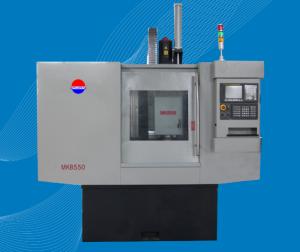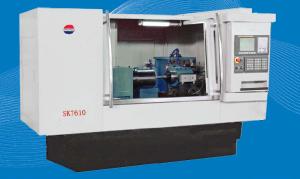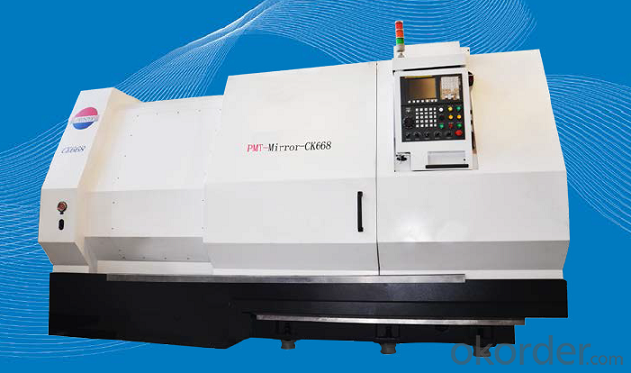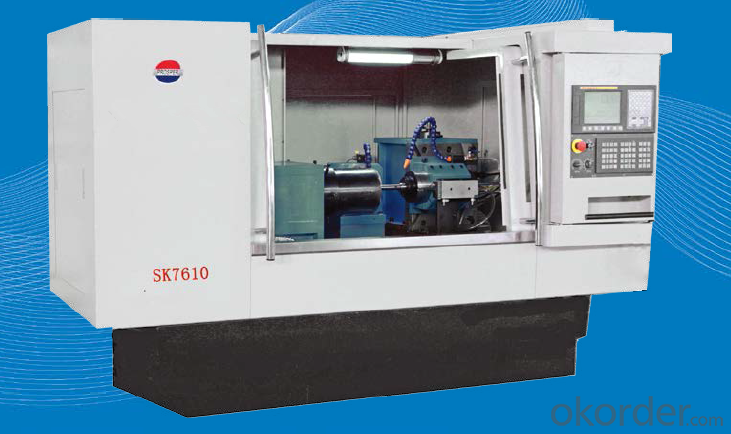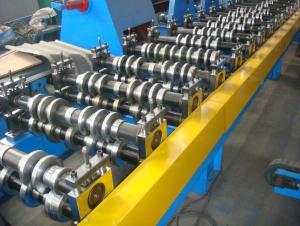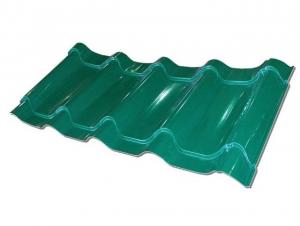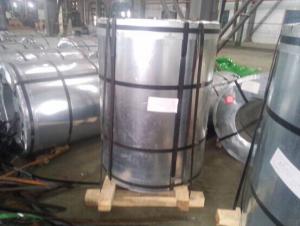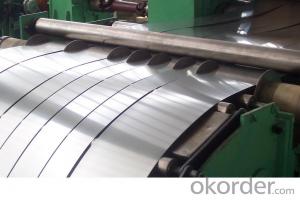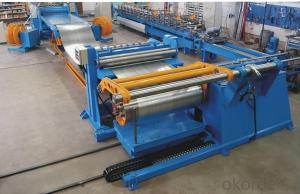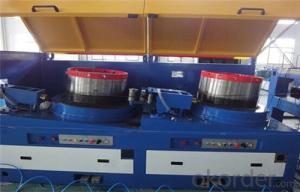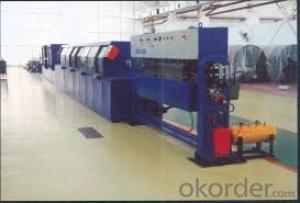CNC machine tool is the abbreviation of Computer numerical control machine tools.
- Loading Port:
- Tianjin
- Payment Terms:
- TT or LC
- Min Order Qty:
- 1 set
- Supply Capability:
- 1000 set/month
OKorder Service Pledge
OKorder Financial Service
You Might Also Like
CNC machine tool is the abbreviation of Computer numerical control machine tools. It is an automatic machine tool equipped with a program control system. The control system can logically process the program specified by the control code or other symbolic instructions, decode it, express it with coded numbers, and input it into the numerical control device through the information carrier. After the arithmetic processing, various control signals are sent by the numerical control device to control the movement of the machine tool, and the parts are automatically processed according to the shape and size required by the drawing.
CNC machine tool solves the problem of complex, precise, small batch and multi-variety parts processing. It is a flexible and efficient automatic machine tool. It represents the development direction of modern machine tool control technology and is a typical mechanical and electrical integration. Chemical products.
Main Advantage
The operation and monitoring of the CNC machine tool are all completed in this CNC unit, which is the brain of the CNC machine tool. Compared with ordinary machine tools, CNC machine tools have the following characteristics:
1. Strong adaptability to the processing object and the characteristics of single-piece production of molds and other products, providing a suitable processing method for the manufacture of molds;
2. High processing accuracy and stable processing quality;
3. Multi-coordinate linkage can be performed, and parts with complex shapes can be processed;
4. When the processing parts change, generally only need to change the CNC program, which can save production preparation time;
5. The machine tool itself has high precision and rigidity, and can choose a favorable amount of processing and high productivity (generally 3 to 5 times that of ordinary machine tools);
6. The high degree of machine tool automation can reduce labor intensity;
7. Conducive to the modernization of production management. CNC machine tools use digital information and standard codes to process and transmit information, and use computer control methods, laying a foundation for the integration of computer-aided design, manufacturing and management;
8. Higher requirements for the quality of the operating personnel and higher technical requirements for the maintenance personnel;
9. High reliability.
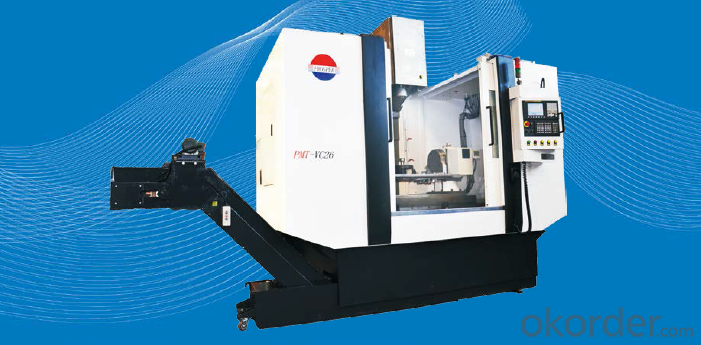
CNC machine tool is an automatic machine tool equipped with a program control system, which can make the machine tool move and process parts according to the programmed program. It integrates the latest technology of machinery, automation, computer, measurement, microelectronics, etc., and uses a variety of sensors. The sensors used in CNC machine tools are mainly photoelectric encoders, linear gratings, proximity switches, temperature sensors, Hall sensors, current Sensors, voltage sensors, pressure sensors, liquid level sensors, resolvers, induction synchronizers, speed sensors, etc., are mainly used to detect position, linear and angular displacement, speed, pressure, temperature, etc.
1. The requirements of CNC machine tools for sensors
1) High reliability and strong anti-interference;
2) Meet the requirements of accuracy and speed;
3) Easy to use and maintain, suitable for the operating environment of the machine tool;
4) Low cost.
Different types of CNC machine tools have different requirements for sensors. Generally speaking, large machine tools require high speed response, and medium and high precision CNC machine tools mainly require accuracy.
2. Application of inductive synchronizer
Inductive synchronizers are made using the principle that the mutual inductance of two planar windings varies with position. Its function is to convert the angle or linear displacement into the phase or amplitude of the induced electromotive force, which can be used to measure the linear or angular displacement. According to its structure, it can be divided into linear type and rotary type. The linear induction synchronizer is composed of fixed length and sliding scale. The fixed length is installed on the machine bed. The sliding scale is installed on the moving parts and moves with the worktable. The stator of the rotary induction synchronizer is a fixed disk and rotor. For spinning discs. The induction synchronizer has the advantages of high precision and resolution, strong anti-interference ability, long service life, simple maintenance, long-distance displacement measurement, good manufacturability and low cost. Rotary induction synchronizers are widely used in turntables of machine tools and instruments and various rotary servo control systems.
- Q: What is the minimum size of the workpiece that metal engraving machinery can handle?
- The minimum size of the workpiece that metal engraving machinery can handle depends on the specific capabilities and specifications of the machinery in question. It would be best to consult the manufacturer's guidelines or specifications for accurate information regarding the minimum size of workpieces that can be engraved using their machinery.
- Q: Can metal engraving machinery be used for engraving on metal utensils?
- Yes, metal engraving machinery can be used for engraving on metal utensils.
- Q: Can metal engraving machinery be used for branding purposes?
- Yes, metal engraving machinery can be used for branding purposes. It enables precise and permanent marking of logos, names, or designs on metal surfaces, which can enhance brand recognition and promote brand identity.
- Q: What is the cooling system used in a metal engraving machine to prevent overheating?
- The cooling system typically used in a metal engraving machine to prevent overheating is a liquid-based system, such as a water or coolant circulation system.
- Q: What is the lifespan of metal engraving machinery?
- The lifespan of metal engraving machinery can vary depending on several factors such as the quality of the machine, frequency of use, maintenance, and technological advancements. However, with proper care and regular maintenance, metal engraving machinery can last for several years, typically ranging from 5 to 15 years or even longer.
- Q: What are the different types of engraving accessories available for metal engraving machinery?
- There are several different types of engraving accessories available for metal engraving machinery. These accessories are designed to enhance the capabilities of the machinery and allow for more precise and intricate engraving on metal surfaces. One common type of accessory is the diamond engraving tool. These tools are made with a diamond tip, which offers exceptional hardness and durability. Diamond engraving tools are ideal for engraving on hard metals such as stainless steel, titanium, and even hardened steel. They provide clean and precise cuts, resulting in high-quality engravings. Another type of accessory is the carbide engraving tool. These tools are made with carbide tips, which are highly resistant to wear and can withstand high temperatures. Carbide engraving tools are suitable for engraving on softer metals such as aluminum, brass, and copper. They offer excellent precision and longevity, making them a popular choice for metal engraving. In addition to the engraving tools, there are also various accessories available for holding and securing the metal piece during engraving. These include vices, clamps, and magnetic holders. These accessories ensure that the metal piece remains stable and secure, allowing for accurate and steady engraving. Furthermore, there are specialized engraving accessories designed for specific applications. For instance, there are rotary engraving attachments that can be used to engrave cylindrical objects such as pens or bottles. These attachments allow for 360-degree engraving, making them perfect for personalized gifts or promotional items. Some metal engraving machines also offer optional accessories such as laser engraving modules. These modules use laser technology to engrave on metal surfaces, providing a different engraving technique compared to traditional engraving tools. Laser engraving offers high precision and can create intricate designs or even reproduce photographs on metal. Overall, the range of engraving accessories available for metal engraving machinery is vast, catering to different materials, applications, and engraving techniques. Whether you need tools for engraving on hard metals, soft metals, or specialized objects, there is likely an accessory available to meet your specific needs.
- Q: Can metal engraving machinery be used for intricate designs?
- Certainly, metal engraving machinery is capable of being used for intricate designs. With technology advancements, modern metal engraving machines are equipped with high precision tools and computer numerical control (CNC) systems. As a result, it is possible to engrave extremely detailed and complex designs on metal surfaces. These machines offer a wide range of capabilities, including variable speed control, adjustable cutting depths, and numerous tooling options. Consequently, it is feasible to engrave intricate patterns, fine lines, delicate curves, and intricate motifs with exceptional accuracy and precision. Moreover, some machines allow for the importation of digital designs, which can be further customized and refined to achieve even more intricate and detailed engravings. All in all, metal engraving machinery is a versatile and powerful tool that enables the creation of stunning and intricate designs on various metal materials.
- Q: What is the minimum diameter of cylindrical objects that metal engraving machinery can handle?
- The minimum diameter of cylindrical objects that metal engraving machinery can handle depends on the specific capabilities of the machine. However, most metal engraving machinery can handle cylindrical objects with a minimum diameter ranging from 1mm to 3mm.
- Q: What are the different types of engraving software used with metal engraving machinery?
- There are several different types of engraving software used with metal engraving machinery, including CAD (Computer-Aided Design) software, CAM (Computer-Aided Manufacturing) software, and specialized engraving software. CAD software is used to create 2D or 3D designs that can be engraved onto metal surfaces. CAM software is then used to convert these designs into machine-readable code that controls the engraving machinery. Finally, specialized engraving software provides additional tools and features specifically designed for the engraving process, allowing for precise control over various parameters such as depth, speed, and tooling options.
- Q: Can metal engraving machinery be used for personal or hobbyist projects?
- Yes, metal engraving machinery can be used for personal or hobbyist projects. Many hobbyists and individuals use metal engraving machinery to create personalized items such as jewelry, keychains, or decorative pieces. With the right equipment and materials, it is possible to achieve high-quality and intricate engravings for personal use or as a hobby.
Send your message to us
CNC machine tool is the abbreviation of Computer numerical control machine tools.
- Loading Port:
- Tianjin
- Payment Terms:
- TT or LC
- Min Order Qty:
- 1 set
- Supply Capability:
- 1000 set/month
OKorder Service Pledge
OKorder Financial Service
Similar products
Hot Searches
Related keywords

